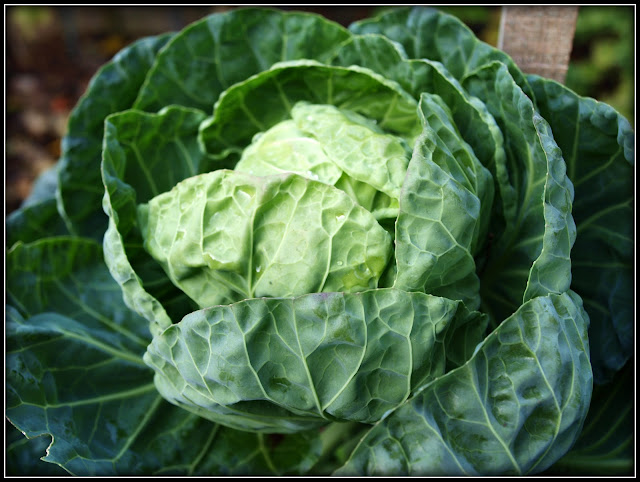This photo of Purple Sprouting Broccoli "Red Arrow", taken with the flash, gives it an almost supernatural look:
Its neighbour, "Rudolph", although less purple, is further advanced and already beginning to put out tiny flowers. These are the embryonic "spears" that we will eventually eat.
The Brussels Sprouts are still frustratingly minuscule. At this rate we'll be eating them for Easter, not Christmas!
I have always been told that you should leave the cabbage-like tops of the Brussels sprout plants in place until the sprouts have been picked, since the plants need them for energy-production. Now I'm not so sure. My blogging friend David Offutt suggests that removing the tops quite early forces the plant to divert energy from the root-system into the sprouts. The results he has achieved are impressive, so maybe I should follow suit.
 |
| Brussels top - "Brilliant" |
Doesn't this make you wonder WHY the leaves are like this? Perhaps it helps with water-retention, or perhaps it traps air to provide better insulation? There has to be a reason for it to have evolved like that, surely. Any ideas?
The best thing about Cavolo Nero and other kales is that you can harvest it progressively, a few leaves at a time, without it looking unduly depleted. We had some yesterday, stirred into some soft polenta - yummy! [More about this to follow soon...]







Parsley is similar really in that it has wrinkled leaves which I guess adds to the surface area of the plant. One advantage would be to absorb more sunlight than a plant with similar sized leaves so maybe this is of advantage in low light conditions. Just a guess though!
ReplyDeleteI asked a professional botantist why the leaves may have evolved and his response was that my guess was as good as his. More surface area can mean the plant loses water quicker and gathers more sunlight which would be an advantage in wet, low light, conditions. (I suppose like winter!)
DeleteHe did say however that as kale was a cultivated species that the curly leaves could have been bred into the plant and not be a response to the environment.
Your Brussel sprouts may be small but I would love to have them anyway. I planted my favorite red Russian kale this time.
ReplyDeleteOh that looks delicious. My sprouts are so tiny compared to yours. So I guess I should be picking mine in May. I don't think the plants are hardy here over the winter, but I guess I'll find out.
ReplyDeleteHi Mark,
ReplyDeleteyes Cavolo Nero is very photogenic.I've got so much of it on my allotment that I'm cutting whole heads rather than leaf by leaf.Cooked in with potatoes and chard makes a good combo ( and great left overs bubbly and squeak)but I'll try it with the soft polenta which has a lovely texture.
For some reason my purple sprouting sown in April (too early?) started producing in late July and has carried on doing so a little at a time.
I was a bit unimpressed with green curly kale at first ,but it seems to have improved with the colder weather.I still have an unopened packet of red kale seeds which I'll give a go next year as the foliage looks so attractive.
I hope you get a good brussel sprout harvest. They are a must for me at Christmas time, although I don't grow them. Wonder can the cabbage-looking top be eaten?
ReplyDeleteI do like the cabbagey top to the brussel sprouts. The texture is not dissimilar to the Kale so perhaps its a less (or more) evolved version of whatever the natural advantage of crinkles is.
ReplyDeleteYour kale looks really good. I do not know either whether there is any evolved advantage in this foliage form. Often new forms in nature ( like variegation) are just chance occurrences and someone has just taken cuttings or taken some seed to be repropagated as garden plants
ReplyDeleteThey all look very good. I've been out of town and out of touch since last week - I apologize for not keeping up!
ReplyDeleteI am going to miss these brassicas very much as I am not sure how they will adapt to our tropical garden now.
ReplyDelete